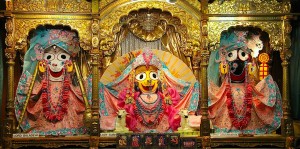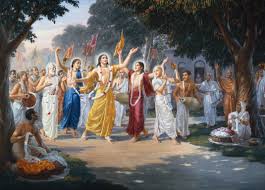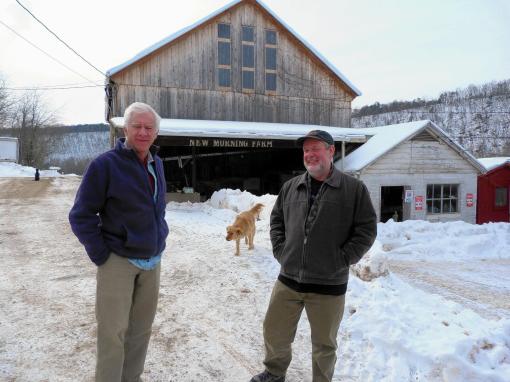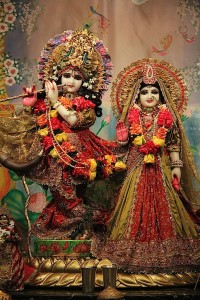ECO-Vrindaban Board Meeting Minutes 2-23-2014.
Mission Statement: ECO-Vrindaban promotes a simple, sustainable lifestyle centered on the care and protection of cows, local food production and the loving service of Lord Krishna, as envisioned by Srila Prabhupada, the Founder-Acharya of ISKCON New Vrindaban.
Participating Members of the ECOV Board of Directors: Anuttama (partial attendance), Bhima, Chaitanya Mangala, Krpamaya, Navin Shyam, and Ranaka. Madhava Gosh did not participate in the Utica Shale gas lease discussion and vote (due to a conflict of interest).
Advisors present: Jaya Krsna
1. Used equipment purchase
WHEREAS: The ECOV Board wishes to acquire proper equipment for its gardening projects, and to facilitate a smooth winding down of the operations of the Small Farm Training Center on INV & ECOV managed properties.
RESOLVED: The Board authorizes up to $6,000 for acquiring implements from the SFTC, including a transplanter, plastic layer/bed former, and chisel plow.
2. Utica Shale Gas Lease
WHEREAS: The ECOV Board wishes to proactively respond to the proliferation of natural gas drilling in and around New Vrindaban so as to minimize the risk of harm to the land and its residents and maximize any potential gains.
RESOLVED: Upon consideration of the inquiries from the New Vrindaban Advocacy Sanga (contained in e-mails dated February 13 and 19) and the respective legal opinions of Mr. William Leon (dated January 30 and February 19), which addressed the following issues:
- Terms of the lease;
- Conflicts of interest;
- Proxy voting by directors;
- Voting by non-resident directors;
- GBC involvement;
- Due diligence on the part of directors;
- Air and water quality protections; and
- Proposed well pad placements,
and after thorough examination of the terms of the proposed leases, in light of the instructions of Srila Prabhupada, the best interests of the community under the circumstances, and the principle of yukta vairagya (as described by Varsana Swami in his paper entitled “Yukta Vairagya and the Gas Drilling Contract”), the ECOV Board hereby authorizes its officers to execute lease agreements as to the Utica Shale formations underlying ECOV-owned lands, subject to the following two internal commitments by the Board:
1) If requested by the legal owner of an affected property, ECOV shall ensure testing of any water supply within a thousand feet of well pads located on either INV or ECOV-managed properties, in accordance with a regimen prescribed by an industry expert;
2) ECOV shall provide a grant of at least $350K toward renovation of Srila Prabhupada’s Palace of Gold, to be provided on a matching basis to any funds expended by INV. This grant shall supersede the previous grant of $100K and loan of $100K, which are both hereby defunded.








 Who are the Pancha-tattva? The Pancha-tattva are a five-fold manifestation of the Supreme Personality of Godhead, featured as five tattvas (truths), namely, isha-tattva (the Supreme Lord), His expansion tattva, His incarnation tattva, His energy tattva and His devotee tattva. These five tattvas incarnate with Lord Chaitanya Mahaprabhu, and thus the Lord executes His sankirtana movement with great pleasure. In Srimad-Bhagavatam (11.5.32) there is the following statement regarding Sri Chaitanya Mahaprabhu:-"In the Age of Kali, people who are endowed with sufficient intelligence will worship the Lord, who is accompanied by His associates, by performance of the sankirtana-yajna." Lord Chaitanya is always accompanied by His plenary expansion Sri Nityananda Prabhu, His incarnation Sri Advaita Prabhu, His internal potency Sri Gadädhara Prabhu and His marginal potency Sriväsa Prabhu. He is in the midst of them as the Supreme Personality of Godhead. One should know that Lord Chaitanya is always accompanied by these other tattvas. Therefore our obeisances to Lord Chaitanya are complete when we say:-
sri-krishna-chaitanya, prabhu-nityananda
sri-advaita gadadhara, srivasadi-gaura-bhakta-vrinda.
Who are the Pancha-tattva? The Pancha-tattva are a five-fold manifestation of the Supreme Personality of Godhead, featured as five tattvas (truths), namely, isha-tattva (the Supreme Lord), His expansion tattva, His incarnation tattva, His energy tattva and His devotee tattva. These five tattvas incarnate with Lord Chaitanya Mahaprabhu, and thus the Lord executes His sankirtana movement with great pleasure. In Srimad-Bhagavatam (11.5.32) there is the following statement regarding Sri Chaitanya Mahaprabhu:-"In the Age of Kali, people who are endowed with sufficient intelligence will worship the Lord, who is accompanied by His associates, by performance of the sankirtana-yajna." Lord Chaitanya is always accompanied by His plenary expansion Sri Nityananda Prabhu, His incarnation Sri Advaita Prabhu, His internal potency Sri Gadädhara Prabhu and His marginal potency Sriväsa Prabhu. He is in the midst of them as the Supreme Personality of Godhead. One should know that Lord Chaitanya is always accompanied by these other tattvas. Therefore our obeisances to Lord Chaitanya are complete when we say:-
sri-krishna-chaitanya, prabhu-nityananda
sri-advaita gadadhara, srivasadi-gaura-bhakta-vrinda. 

 “O devotee of the Lord, to see you is the perfection of the eyes, to touch your body is the perfection of bodily activities, and to glorify your qualities is the perfection of the tongue, for it is very rare to find a pure devotee like you.” [Hari-bhakti-sudhodaya (13.2), quoted in CC Madhya 20.61]
“O devotee of the Lord, to see you is the perfection of the eyes, to touch your body is the perfection of bodily activities, and to glorify your qualities is the perfection of the tongue, for it is very rare to find a pure devotee like you.” [Hari-bhakti-sudhodaya (13.2), quoted in CC Madhya 20.61]  Devotees from the ISKCON New Govardhana farm perform the congregational chanting of the Holy Names to spread transcendental awareness amongst the residents and tourists of the Byron Bay which is a beachside town located in the far-northeastern corner of the state of New South Wales, Australia.
Devotees from the ISKCON New Govardhana farm perform the congregational chanting of the Holy Names to spread transcendental awareness amongst the residents and tourists of the Byron Bay which is a beachside town located in the far-northeastern corner of the state of New South Wales, Australia.  In the Pancaratra scriptures there is a saying that in the ultimate analysis devotion is the only element which might cause the Lord to appear. That’s how the small Panca-tattva came, due to the great desire and devotion of His devotees. Then, as long as the devotee wishes to serve Him, the Lord reciprocates in the same way.
Regarding the big Panca-tattva Deities, a whole book has been written on how They were manifested, first in South India, and then installed in Sri Mayapur dhama.
In the Pancaratra scriptures there is a saying that in the ultimate analysis devotion is the only element which might cause the Lord to appear. That’s how the small Panca-tattva came, due to the great desire and devotion of His devotees. Then, as long as the devotee wishes to serve Him, the Lord reciprocates in the same way.
Regarding the big Panca-tattva Deities, a whole book has been written on how They were manifested, first in South India, and then installed in Sri Mayapur dhama.  On 3rd March, 2014, the worldwide vaisanva community gathered at Mayapur to celebrate the 10th Anniversary of Sri Panca Tattva Installation in Mayapur. Around 6000 devotees were already in Mayapur, taking part in the kirtan mela. Thousands more devotees arrived yesterday and today from all over the world. A Maha Abhiseka was performed to Sri Panca Tattva. This is the mercy of Their Lordship Sri Panca-Tattva, who have manifested at Mayapur in Their magnificent 7ft deity form. Once again, They are gathering devotees together so they can relish the pastimes of the Lord in the association of His dear devotees.
On 3rd March, 2014, the worldwide vaisanva community gathered at Mayapur to celebrate the 10th Anniversary of Sri Panca Tattva Installation in Mayapur. Around 6000 devotees were already in Mayapur, taking part in the kirtan mela. Thousands more devotees arrived yesterday and today from all over the world. A Maha Abhiseka was performed to Sri Panca Tattva. This is the mercy of Their Lordship Sri Panca-Tattva, who have manifested at Mayapur in Their magnificent 7ft deity form. Once again, They are gathering devotees together so they can relish the pastimes of the Lord in the association of His dear devotees. 
